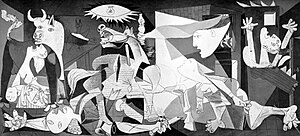Guernica (painting)
From Wikipedia, the free encyclopedia
 |
| Guernica |
| Pablo Picasso, 1937 |
| Oil on canvas |
| 349 × 776 cm, 137.4 × 305.5 in |
| Museo Reina Sofia, Madrid |
Guernica is a monumental painting by Pablo Picasso, depicting the Nazi Germanbombing of Guernica, Spain, by twenty-eight bombers, on April 26, 1937 during the Spanish Civil War. The attack killed between 250 and 1,600 people, and many more were injured.
The Spanish government commissioned Pablo Picasso to paint a large mural for the Spanish display at the Paris International Exposition (the 1937 World's Fair inParis). The Guernica bombing inspired Picasso. Within 15 days of the attack, Pablo Picasso began painting this mural. On completion Guernica was displayed around the world in a brief tour, becoming famous and widely acclaimed. This tour brought the Spanish civil war to the world's attention. Guernica epitomizes the tragedies of war and the suffering war inflicts upon individuals. This monumental work has eclipsed the bounds of a single time and place, becoming a perpetual reminder of the tragedies of war, an anti-war symbol, and an embodiment of peace.
Guernica is of remarkable size, solely black and white, 3.5 metre (11 ft) tall and 7.8 metre (25.6 ft) wide, a mural-size canvas painted in oil. Picasso's purpose in painting it was not to create the non-representational abstraction typical of some of his contemporaries, such asKazimir Malevich. Guernica presents a scene of death, violence, brutality, suffering, and helplessness without portraying their immediate causes. The choice to paint in black and white conveys the chronological nearness of a newspaper photograph and the lifelessness war affords.
Guernica depicts suffering people, animals, and buildings wrenched by violence and chaos.
A tapestry copy of Picasso's Guernica is displayed on the wall of the United Nations building in New York City, at the entrance to theSecurity Council room. It was placed there as a reminder of the horrors of war. Commissioned and donated by Nelson Rockefeller, it is not quite as monochromatic as the original, using several shades of brown.


No comments:
Post a Comment